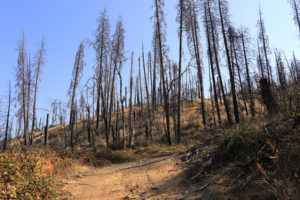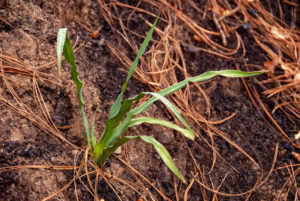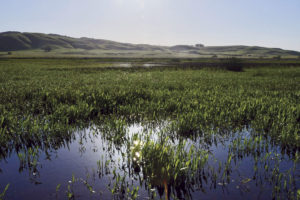
A quiet cemetery rests behind a metal fence at the end of a cul-de-sac in the Northern California city of Shasta Lake, beyond houses touting American flags. Our white pickup truck slows to a stop in front of the fence as two deer bound across the road, toeing the line between nature and suburbia. Caleen Sisk, chief of the Winnemem Wintu tribe, sits across from me in the driver’s seat, an 84-year reminder of what her people lost etched into the earth in front of our eyes. Caleen is 69 years old, with long black hair that’s shaved just above her ears, revealing peppered gray sideburns. She was born and now lives about 10 miles northeast of this cemetery, in a village at the end of a bumpy dirt road you’d miss if you weren’t paying attention. But her ancestors’ land stretches all the way to Mt. Shasta, the source of the McCloud River that runs down from the mountain between the parallel Sacramento and Pit Rivers. The name “Winnemem” has its origins here — it means “middle water.”
At the cemetery, the September earth is dry. Oak and pine trees dot the landscape, dead grass sways in the wind like a cigarette awaiting a light, and a dirt path continues straight ahead into the woods, dividing the cemetery into north and south, like a canyon separating one world from another.
On the left, facing down into the rest of California, the graves are marked by what look like wooden garden stakes. They’re sparse, and a few are decorated with flowers or flags. Caleen tells me these are the memorials for the mostly white residents of nearby towns. On the other side, graves are grouped by names, which are meticulously engraved into thick wood planks in all caps. The heads of the deceased face north, towards the McCloud River, according to Caleen. The names are Winnemem — Curl, Antler, Sisk — a people who have lived in the area for centuries. But this is not where they were first buried. To make space for a massive federal water project, Winnemem Wintu bodies were dug up and moved.
The story of the Winnemem Wintu’s forced eviction, like the eviction stories of Indigenous tribes across what is now the United States, began with genocide. But the genocidal chapter of Winnemem history is much more recent compared with tribes located farther east. It was just 170 years ago that Shasta City, only 13 miles southwest of the cemetery Caleen drove me to, paid settlers bounties for Native heads.
The Winnemem Wintu who survived the Gold Rush-era terror were shoved off much of their land. And while the methods for displacement became more subdued over time, they haven’t stopped. In the last century, as the federal government has been forced to confront California’s environmental shortcomings, it has turned to Winnemem Wintu land for water. And doing so has displaced them even more.
The modern chapter began about a hundred years ago, when California realized it could never reach its agricultural potential without more water. In 1921, the state began studying a plan to take water from the places and people that had it, and redistribute it to the businesses and industries that didn’t. But amid the Great Depression, California needed help from the federal government to fund the project. So under the Franklin Roosevelt administration, the feds assumed control and built a series of dams, reservoirs, and canals. By the early 1940s, Shasta Reservoir, the state’s largest, flooded Winnemem Wintu village sites on the banks of the McCloud River. It flooded their graves.
At various points over the last few decades, the Interior Department has pursued a new plan to raise the height of Shasta Dam, which would flood even more Winnemem Wintu land. The project is stalled because its current blueprint violates California law and Congress won’t fund it, but there’s little stopping a future administration or Congress from signing off on the expansion.
Over the last century, federal agencies have made a series of decisions about water and land management and tribal recognition that have pushed the Winnemem Wintu to their breaking point. Five months ago they almost lost their 42-acre village to a wildfire. Without the federal resources most tribes receive, they have been pushed into poverty. Dozens of their ceremonial sites lie in a state of perpetual precarity unless the Bureau of Reclamation, couched within the Interior Department and charged with operating Shasta Dam, abandons the dam raise project.
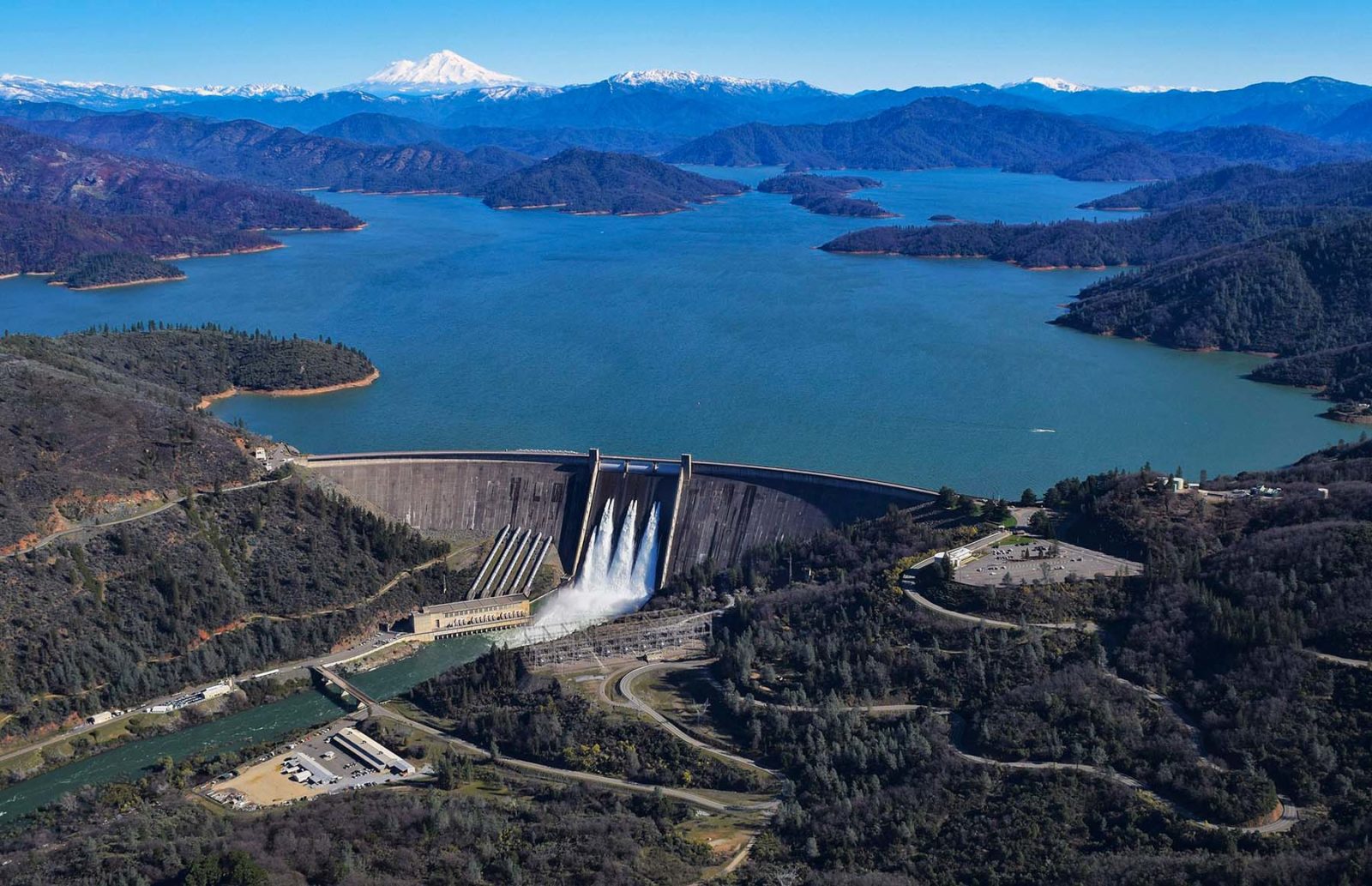
The Central Valley Act
Between 1933 and 1941, Congress and Reclamation approved the project that would move Northern California’s water to the south — the Central Valley Project. In the summer of 1938, Reclamation gave the Winnemem Wintu two months to dig up as many of their ancestors’ graves as they could before Shasta Reservoir flooded the land on which they were buried. By September of that year, 183 Winnemem graves had been moved to the cemetery Caleen drove me to. Florence Jones — or Grams — Caleen’s great aunt and the Winnemem’s spiritual leader at the time, oversaw the grave transfer, “which was almost an impossible act for the Winnemems to do,” Caleen told me. “Because you don’t do that. You don’t dig people up. You don’t disrupt their resting place.”
If you drive east from the cemetery, crossing Interstate 5 and the northern edge of the city of Redding, you’ll come across a long, winding road surrounded by humble ranches and fields of wild grasses. On a trip to see Caleen in mid-November 2021, I follow that route until I arrive at a metal gate that opens onto a bumpy dirt road that leads to all the land that’s left in Winnemem Wintu possession — a 42-acre village at the southern edge of the Shasta-Trinity National Forest. Just down the road there’s a small grocery market and a dive bar.
Disheveled, friendly dogs greet me as I drive over a small pothole and a puddle. As I turn around a corner, several large trailers and an old house with chipped white paint come into view. This village is just four miles south of Shasta Reservoir’s southern edge, the lake that inundated the tribe’s original burial grounds and many of their village sites almost a century ago. The federal government gave itself the right to do this with a 1941 law called the Central Valley Project Indian Lands Acquisition Act.
The 1941 act stated that “the Secretary of the Interior shall determine the amount of money to be paid to the Indians as just and equitable compensation.” Unless just and equitable compensation was $0, the federal government never upheld this part of the act. According to Caleen, the Winnemem were simply informed that much of their land would be flooded. The one thing they were supposed to receive was another place to live — more land elsewhere. But this promise was never fulfilled. “The only thing they did in compliance with that law was create this Indian cemetery,” said Claire Cummings, an attorney who has worked with the Winnemem Wintu for about 30 years.
Back at the cemetery, as the two of us sat in her Chevy, Caleen’s eyes focused on the dirt path ahead, and she shook her head, exasperated. The cemetery is a reminder of all that her tribe lost. Their river stopped running with salmon. Their homes were submerged, only to appear in the very driest of years, as artifacts of a distant time. And it was all “for this,” she said, gesturing in front of us. “This is the only free thing that we have … a place to bury.”
Although the Winnemem have fought to hold onto their land every step of the way, they’ve faced an uphill battle, in part because they are not recognized as a tribe by the federal Bureau of Indian Affairs. The reason is long and bureaucratic, and boils down to a discrepancy between a Supreme Court ruling and a BIA decision — some California tribes, including the Winnemem Wintu, won a lawsuit for resources and recognition that lasted from 1928-72, but in 1978, the BIA began a new formal recognition process, and the Winnemem Wintu were left off their list of tribes.
Federally recognized tribes — such as the Yurok, Federated Indians of Graton Rancheria, and Kashia Band of Pomo in California — are legally entitled to certain federal resources and services, like reservations, grants, and sovereignty respected by the federal government. To access any of these things, the Winnemem Wintu would need to endure an application process that would culminate in the BIA deciding whether or not they are a tribe — a process in which Caleen refuses to participate.
“We want the freedom to be Winnemem, and we are deserving of support for the taking of our lands and waters and everything that was lost,” she said. “But when I look at other federally recognized tribes … they have to jump through hoops to utilize some of that federal money.”
She has considered other avenues, like trying to get a state-sponsored reservation, and reopening the 50-year-old court case that was supposed to guarantee resources for the Winnemem. But so far, her tribe remains unrecognized in the eyes of the federal government. And this has made it much harder to fight off the agricultural interests that continue to encroach on their land and river.
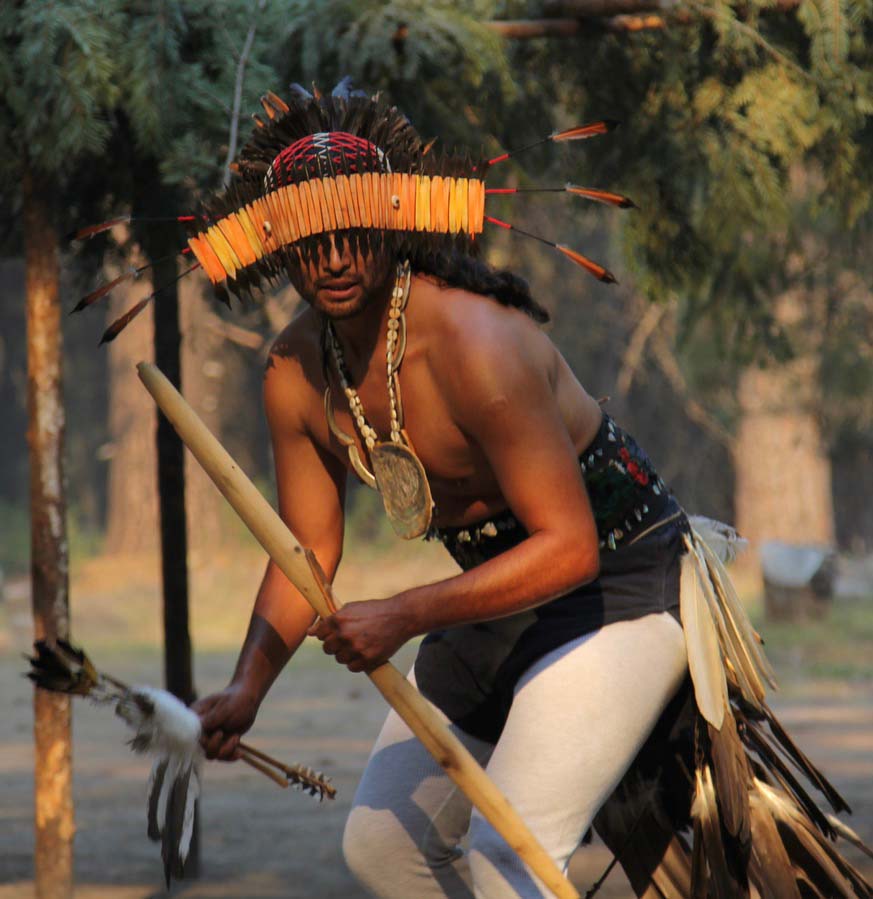
An Unquenchable Thirst
The CVP was not conceived for a California population of nearly 40 million. When the project was approved in the 1930s, there were about 6 million people in the state. California’s complementary State Water Project was constructed in the 1960s and 1970s, and mostly supplies water for municipal use. But even that was only designed for a population of around 25 million.
As the state’s population soared exponentially, so did Redding’s — the city located just south of Shasta Reservoir. The Bureau of Reclamation needed workers to build Shasta Dam, so droves of men flocked there. But the real growth happened in the following decades. The city’s population grew from about 16,000 in 1970 to nearly 90,000 in 2010.
Caleen grew into adulthood during the population boom. She watched the McCloud River attract visitors in loud motorboats. Once quiet meadows at the base of Mt. Shasta began to show signs of human footprints — literally. The demand for water kept growing.
The state surpassed the 25 million mark in the mid-‘80s, and in 1992, the federal government authorized an update to the CVP. But it didn’t address the elephant in the room — California didn’t have enough water to support its agriculture ambitions and its growing population. As Caleen explained it to me, Reclamation has been promising more water to its contractors than CVP reservoirs can provide.
Between 2012 and 2021, CVP agricultural contractors south of the Bay-Delta region only received their full water contract amounts once, in 2017, according to a December report from the Congressional Research Service. On average, those contractors received just 31 percent of their allotted water each year from 2012-21. In the two decades before that, it was still only about 65 percent. In 2014, 2015, and 2021, they received 0 percent. The latest projections for 2022 allocations follow suit — 0 percent.
As I sat in her kitchen in November, Caleen chuckled as she recalled a time in 2006, when she asked the U.S. Forest Service to close off a part of the McCloud River within its jurisdiction to motorboats so the tribe could hold a ceremony. She said she had to fight for that closure because the water levels were high and there were motorboats everywhere. But last year, there was hardly any water. “There’s no fear of any motor boats coming up that rocky river,” she said.
Reclamation has considered raising the height of Shasta Dam since the 1980s, to expand the reservoir’s storage capacity in wet years. But even though those years are becoming increasingly rare, Congress approved a preliminary $20 million to fund the project in early 2018. Until recently, the most vocal proponent of the dam raise was the Fresno-based Westlands Water District, the largest agricultural water district in California and the CVP’s largest agricultural contractor.
Former Westlands lobbyist David Bernhardt was appointed Interior Secretary in 2019 by Donald Trump. During Bernhardt’s tenure at Interior, the Bureau of Reclamation — which lies within Interior — awarded Westlands a permanent water contract large enough to provide twice the amount of water used by the 4 million residents of Los Angeles each year.
In order to legally access many of their ceremonial sites, the Winnemem Wintu must get permission from public and private landowners. One 7-mile long patch of the McCloud River — that could be flooded in wet years if the dam is raised — is home to the tribe’s Puberty Rock. The landowner is a fishing club. The owner of the fishing club is Westlands Water District.
Anticipating the dam raise, Westlands bought the Bollibokka Fishing Club in 2007, so it wouldn’t have to deal with a different landowner potentially fighting the project. Westlands also initially agreed to pay for part of the dam raise itself.
But despite its power, Westlands has suffered from recent droughts. Like other CVP contractors, Westlands has been receiving a small fraction of the water it’s legally entitled to — or, several times in the last decade, none of the water it’s legally entitled to. And after the initial $20 million Congress approved for the dam raise, legislators rejected further funding requests from Reclamation. The state of California has long opposed the project, and former California Attorney General Xavier Becerra sued Westlands in 2019 for violating a California law protecting “wild and scenic” rivers. A judge granted an injunction banning Westlands from participating in the dam project, and the case was settled in November 2019 with an agreement that Westlands would not assist or cooperate in any attempt to raise the dam. Westlands spokesperson Shelley Cartwright confirmed that Westlands is no longer pursuing the dam raise.
Beyond the politics and legal feasibility of the dam expansion project, it also doesn’t really make sense from a water standpoint, according to Brian Gray, a senior fellow at the Public Policy Institute of California’s Water Policy Center. “The idea that building more [surface water] storage is going to be a big part of the solution is just a fallacy at this point,” he said. After all, reservoirs are only useful to the extent that water flows into them.
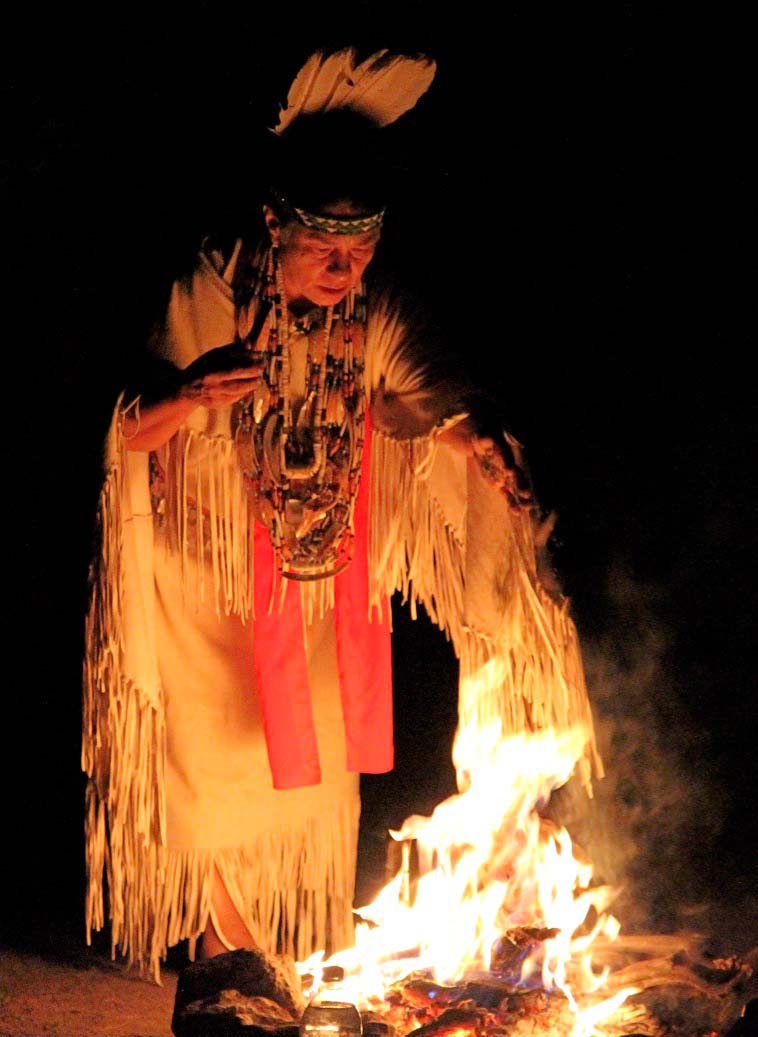
Water and Fire
The first time I was scheduled to meet Caleen was a warm Thursday evening in September. The plan was for me to stop at Shasta Dam and talk to someone about its operations, then meet Caleen to talk about the dam raise project and drought. But as I drove into Redding, I watched smoke billow over the top of Bear Mountain, a peak right next to the Winnemem Wintu village, basically in their backyard. The Fawn Fire had ignited from an act of arson at 4:45 p.m. the day before, spreading rapidly Thursday as winds picked up.
Caleen kept tabs on the fire throughout the day, and around mid-afternoon, she and her son Michael got into her truck and drove down to the gate at the southern edge of the 42-acre village. Roads to the west were already closed. They needed to get out.
“You don’t even want to recognize it,” Caleen sighed as she recounted the evacuation the next day on the back patio of the Win-River Casino, where she was staying. “I was going through my mind, you know, I was like, I got the goats, I got the horses, got my chickens.” Her grandchildren were in school, so at least she knew they were safe.
Caleen packed up pretty quickly, but she paused for a moment in her trailer. Her grandson Net Chi didn’t have his laptop with him. She made a mental note to bring it, but in the midst of wrangling chickens, goats, and people, she forgot.
“Once you start gathering things, it’s like, what’s the most important? I took some pictures off the wall, grabbed my language books and papers. But I couldn’t get all the paperwork.”
As too many Californians know, evacuating your home because of a wildfire is jarring. But for Caleen, it didn’t come as a huge surprise. Throughout her life, she said, she had seen how the extractive industries that fuel climate change laid the groundwork for a society ill-prepared to face earth’s backlash. The Fawn Fire was the first that forced Caleen and the 30 or so other Winnemem who live in the 42-acre village to evacuate, but it was far from the first wildfire that broke out nearby.
Just as the federal government never quite figured out how to best manage water in California, it also has a history of missteps when it comes to forest management.
A series of giant, devastating wildfires that burned through Montana, Idaho, and Washington in 1910 convinced the U.S. Forest Service (which was established just five years earlier) that the only way to prevent such an event from happening again was total fire suppression. That strategy framed USFS policies for the next several decades. Beginning in the 1960s, scientists started to realize that fire itself played an important role in forest ecology (many Indigenous tribes already knew this). But as wildfires have become larger and more dangerous in recent years, the USFS has once again prioritized fire-fighting, in part out of necessity. But that means the funds that could be going to land management and forest thinning are used for putting out fires instead. Caleen framed it succinctly. “Fire has been missing from the forest management.”
Yana Valachovic, a northern California forest advisor at the California Fire Science Consortium, echoed this thought. “We’ve had over a century of fire suppression, and we’ve had sort of a brazen attitude as a society that we can control most fires,” she said.
Today, our forests are more fire-prone than ever, like giant tinderboxes. And while climate change didn’t cause our fire problems, it absolutely exacerbates them — hotter temperatures and drought make for prime wildfire conditions. And it’s not just California. Human-caused climate change has contributed to a doubling of area burned by wildfires across the western United States since the 1980s, according to the most recent report from the United Nations Intergovernmental Panel on Climate Change, published on Feb. 28.
Caleen told me she has offered to work with the USFS to restore nearby oak groves, which would increase the health of the forest. But she said the agency dismissed the idea. I tried to ask the tribal relations program manager for Shasta-Trinity National Forest about this, but he didn’t want to talk.
When I drove to meet Caleen at the village in November, I could see the remnants of the Fawn Fire. Along Bear Mountain Road, which leads from Redding east to the village, patches of trees were scorched on either side. As we sat in her kitchen, I asked Caleen what changes she noticed in the surrounding landscape over time. She recalled autumns full of rain and Novembers blanketed in snow when she was a child. “But then that started changing, and pretty soon it was like, no snowing. Every once in a while, like every five years or so, there might be a little dropping of snow in Redding, but not like it used to be.”
When she was growing up, the top of Mt. Shasta was covered in snow year-round. Slowly, she noticed brown spots appearing during the summers, getting larger every year. In the early ’90s, when she was in her early forties, she asked Grams about it. “I said to Grams, what’s happening when Mt. Shasta is not getting snow? And Grams says she’s taking off her coat because people don’t respect her, and they misuse and abuse her all the time. And so she’s going to take off her coat and get their attention.”
Historically, California has relied on snowpack for about 30 percent of its water supply. Both the CVP and SWP make their water allocations in part based on snowpack. But as temperatures continue to rise, snowpack is expected to decline, which will further jeopardize the state’s usable water supplies, according to the PPIC’s Gray.
The summer of 2021 was the first time in Caleen’s memory that Mt. Shasta had no snow at all. “I wish Grams was here to say, what does that mean? How is she going to put back her coat? Or will she? Will it continue until people learn, learn how to appreciate? And it’s water, that’s what they don’t appreciate.”

Through A Different Lens
California recorded its driest water year in a century in 2020-2021. The years between 2000 and 2021 were recently deemed the driest 22 consecutive years in the North American southwest since the year 800, according to a Nature study. Reservoirs have been depleted and emergency drought proclamations are ubiquitous. Shasta’s levels are critically low, yet Reclamation’s plans to raise the height of the dam haven’t been entirely abandoned. And it’s not even clear how much more water could be stored if the reservoir’s capacity were to increase. “In really, really wet years when Shasta is full, it would be able to store more water,” said water and climate scientist Peter Gleick, “but … those years are few and far between.”
And worsening drought has come with worsening fires.
The eight largest wildfires in California history occurred in the last five years. Six of those broke out in northern California. In September 2021, the flames of the Fawn Fire, which was relatively small, came within about 20 feet of a trailer at the Winnemem Wintu village.
“Most people coming here wouldn’t realize what the dream is, about bringing people together,” Caleen explained when I visited in November. “Most of these trailers are either free or almost too cheap to salvage. But it allows people to live here.”
Caleen is used to having to explain her tribe’s worth. But it has taken a toll. Instead of spending her time teaching the younger generations everything she learned from Grams and her other elders, she spends hours in meetings with various government agencies, or in interviews with journalists like me.
“We are at the breaking point,” she told me. “We’ve been away from our river since the ‘40s and we have lost all of our elders who came through that time to the ‘80s. And so now we are without those elders who actually grew up on that river, who carried all those songs and dances and knowledge … those things are being lost about the importance of the environment and what it tells us.”
Caleen told me that when a Winnemem person dies, the men of the tribe dig the grave for their loved one themselves as a way to work through their grief, and because that’s the last thing they’ll do for that person. “They’re not going to stack their wood no more, they’re not going to drive them to town no more,” Caleen said. “This is the physical thing that they’re going to do, and then they’re going to carry the casket and put them down.”
Caleen said she’s watched non-Native funerals where loved ones say their respects, leave, and then whoever is working the service lowers the casket into the ground and covers it. But to her, that’s incomplete. She told me Winnemem people never leave the cemetery until the casket is in the ground, the dirt is filled in, and the flowers are placed on top.
I went back up to the village one more time in February. While I was there, I asked Caleen what she wants most for her tribe. Her answer was simple — she wants the Winnemem to survive. Not just as individuals, dispersed in neighborhoods throughout the state and country, but as Winnemem Wintu. She doesn’t want the tribe to apply for federal recognition if it means giving up a part of who they are. She doesn’t want to have to ask permission from various landowners to hold ceremonies on her tribe’s lands. She certainly does not want Shasta Dam to be raised, which could inundate even more important cultural sites.
“If there was any justice for Winnemem people to continue to be Winnemem, that would be a miracle,” she said. “We’re backed up to the farthest point that we can go, that we have to break the law to be here, to have our family here, because there’s no other avenues unless we just want to give it up and just go live in a neighborhood. Forget about being Winnemem. Forget about going to the river and praying. Forget about the songs and the dances. That’s what they’re asking us to give up if we want to be Americans. Or is there somewhere in America that would allow the first peoples to continue the way they believe? Why can’t we do that?”

